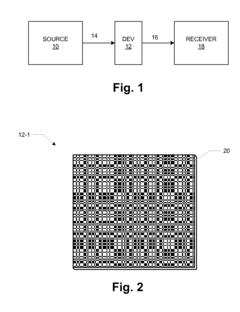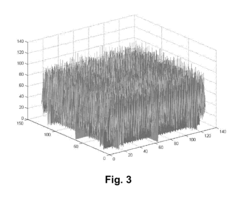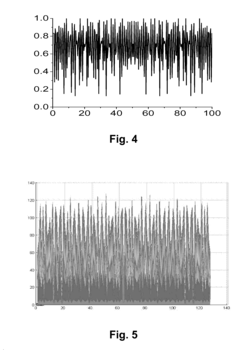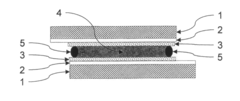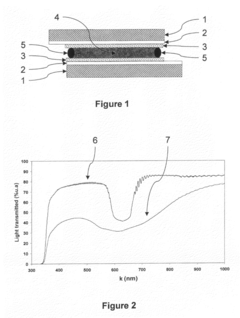How to Exploit Quasicrystal's Reflective Properties?
Quasicrystal Reflectivity Background and Objectives
Quasicrystals, discovered in 1982 by Dan Shechtman, represent a unique class of materials that exhibit long-range order but lack periodicity. This discovery challenged the conventional understanding of crystalline structures and opened up new avenues for materials science research. The reflective properties of quasicrystals have garnered significant attention due to their potential applications in various fields, including optics, electronics, and energy harvesting.
The study of quasicrystal reflectivity has evolved significantly over the past four decades. Initially, researchers focused on understanding the fundamental nature of quasicrystalline structures and their diffraction patterns. As the field progressed, attention shifted towards exploring the unique optical properties that arise from the aperiodic arrangement of atoms in quasicrystals.
One of the key objectives in exploiting quasicrystal reflective properties is to harness their ability to manipulate light in ways that conventional crystals cannot. Quasicrystals exhibit photonic band gaps and localization of electromagnetic waves, which can lead to novel optical phenomena such as enhanced light absorption, selective reflection, and unusual light propagation characteristics.
The development of advanced fabrication techniques has been crucial in advancing quasicrystal research. Methods such as molecular beam epitaxy, self-assembly, and lithography have enabled the creation of artificial quasicrystalline structures with tailored optical properties. These advancements have paved the way for the design of quasicrystal-based optical devices and coatings with enhanced reflective capabilities.
Recent technological trends in this field include the exploration of quasicrystalline metamaterials, which combine the unique properties of quasicrystals with the engineered characteristics of metamaterials. This synergy aims to create materials with unprecedented control over light reflection, absorption, and transmission across a wide range of wavelengths.
The primary goal of current research is to develop practical applications that leverage the distinctive reflective properties of quasicrystals. This includes the creation of high-efficiency solar cells, advanced optical filters, and novel sensing devices. Additionally, researchers are investigating the potential of quasicrystals in thermal management applications, exploiting their ability to reflect specific wavelengths of infrared radiation.
As the field continues to evolve, interdisciplinary collaborations between materials scientists, physicists, and engineers are becoming increasingly important. These partnerships aim to bridge the gap between theoretical understanding and practical implementation, driving innovation in quasicrystal-based technologies and expanding their potential applications across various industries.
Market Analysis for Quasicrystal Applications
The market for quasicrystal applications, particularly those exploiting their unique reflective properties, is experiencing significant growth and diversification. Quasicrystals, with their non-periodic atomic structure, exhibit exceptional optical and electromagnetic characteristics that set them apart from traditional crystalline materials. This has led to a surge in research and development activities across various industries seeking to harness these properties for innovative applications.
In the aerospace sector, quasicrystals are being explored for their potential in creating advanced thermal barrier coatings. Their unique atomic arrangement allows for superior heat reflection, potentially improving the efficiency and durability of aircraft engines. This market segment is expected to see substantial growth as manufacturers seek ways to enhance fuel efficiency and reduce maintenance costs in commercial and military aviation.
The telecommunications industry is another key market for quasicrystal applications. The material's ability to manipulate electromagnetic waves in novel ways has sparked interest in developing high-performance antennas and signal processing devices. As 5G and future wireless technologies continue to evolve, the demand for materials that can efficiently manage and direct electromagnetic signals is likely to increase, positioning quasicrystals as a valuable resource in this sector.
In the field of optics and photonics, quasicrystals are gaining traction for their potential in creating advanced optical coatings and photonic devices. Their unique reflective properties make them ideal candidates for developing more efficient solar cells, high-performance mirrors for telescopes, and novel light-emitting devices. This market segment is expected to grow as the push for renewable energy sources and advanced imaging technologies intensifies.
The automotive industry is also showing interest in quasicrystal applications, particularly for developing new types of reflective coatings for vehicle windows and bodies. These coatings could enhance energy efficiency by reflecting infrared radiation, potentially reducing the load on air conditioning systems and improving fuel economy. As automakers strive to meet increasingly stringent environmental regulations, the market for such innovative materials is likely to expand.
In the consumer electronics sector, quasicrystals are being investigated for their potential in creating more durable and scratch-resistant coatings for screens and device casings. Their unique surface properties could lead to the development of displays with enhanced optical clarity and reduced glare, addressing common consumer pain points in mobile devices and televisions.
While the market for quasicrystal applications is still in its early stages, the potential for growth is substantial. As research continues to uncover new ways to exploit the reflective properties of quasicrystals, we can expect to see an expansion of applications across multiple industries. This growth will likely be driven by the increasing demand for advanced materials that can offer superior performance in optical, thermal, and electromagnetic applications.
Current Challenges in Quasicrystal Reflectivity
Despite the promising potential of quasicrystals' reflective properties, several significant challenges currently hinder their full exploitation. One of the primary obstacles is the difficulty in synthesizing large-scale, high-quality quasicrystals with consistent reflective properties. The complex, aperiodic structure of quasicrystals makes their growth process highly sensitive to environmental conditions, resulting in variations in quality and performance across different samples.
Another major challenge lies in the precise control and manipulation of quasicrystals' reflective properties. While their unique structure offers intriguing possibilities for light manipulation, researchers struggle to fine-tune these properties for specific applications. The lack of a comprehensive understanding of the relationship between quasicrystal structure and reflective behavior impedes the development of tailored solutions for various optical and photonic applications.
The integration of quasicrystals into existing optical systems and devices presents another significant hurdle. Conventional optical components are typically designed for periodic structures, and incorporating aperiodic quasicrystals often requires substantial modifications to existing manufacturing processes and design paradigms. This integration challenge slows down the adoption of quasicrystal-based reflective technologies in practical applications.
Furthermore, the characterization and measurement of quasicrystals' reflective properties pose unique challenges. Traditional techniques for analyzing periodic crystal structures are often inadequate for capturing the complex behavior of quasicrystals. Developing new, more sophisticated measurement methods and analytical tools is crucial for accurately assessing and optimizing quasicrystal reflectivity.
The stability and durability of quasicrystals under various environmental conditions also remain concerns. Many potential applications, such as solar energy harvesting or aerospace technologies, require materials that can maintain their reflective properties over extended periods and under harsh conditions. Ensuring the long-term stability of quasicrystals without degradation in their reflective performance is a critical challenge that needs to be addressed.
Lastly, the scalability of quasicrystal production for commercial applications presents both technical and economic challenges. Current synthesis methods are often limited to small-scale production, making it difficult to meet the potential demand for large-scale applications. Developing cost-effective, scalable manufacturing processes while maintaining the quality and consistency of quasicrystals' reflective properties is a significant hurdle that needs to be overcome for widespread adoption of this technology.
Existing Methods for Exploiting Quasicrystal Reflectivity
01 Optical properties of quasicrystalline materials
Quasicrystals exhibit unique optical properties due to their aperiodic structure. They can reflect light in ways that differ from traditional crystalline materials, potentially offering enhanced reflectivity across a broader spectrum of wavelengths. This property makes them interesting for applications in optical coatings and reflective surfaces.- Optical properties of quasicrystalline materials: Quasicrystals exhibit unique optical properties due to their aperiodic structure. They can reflect light in unusual ways, creating interesting visual effects. These materials can be used in various applications where specific light reflection or diffraction patterns are desired, such as in decorative coatings or optical devices.
- Quasicrystalline coatings for enhanced reflectivity: Quasicrystalline materials can be applied as coatings to enhance the reflective properties of surfaces. These coatings can provide improved light reflection, heat reflection, or electromagnetic wave reflection. They are particularly useful in applications requiring high reflectivity or specific reflection patterns.
- Quasicrystalline structures in photonic applications: Quasicrystalline structures can be designed and fabricated for use in photonic applications. These structures can manipulate light in ways that periodic structures cannot, leading to novel optical effects and improved performance in devices such as lasers, sensors, and optical computing components.
- Tunable reflective properties of quasicrystals: The reflective properties of quasicrystals can be tuned by adjusting their composition, structure, or external conditions. This tunability allows for the creation of materials with specific reflective characteristics, which can be useful in applications such as smart windows, adaptive optics, or color-changing surfaces.
- Quasicrystalline materials for electromagnetic shielding: Quasicrystals can be used to create effective electromagnetic shielding materials. Their unique structure allows them to reflect or absorb electromagnetic waves across a wide range of frequencies, making them suitable for applications in electronics, telecommunications, and defense industries.
02 Quasicrystalline coatings for improved reflectivity
Quasicrystalline materials can be used as coatings to enhance the reflective properties of various surfaces. These coatings can be applied to metals, ceramics, or other substrates to improve their ability to reflect light or other electromagnetic radiation. The unique structure of quasicrystals allows for the creation of highly reflective surfaces with potential applications in solar energy and optics.Expand Specific Solutions03 Photonic quasicrystals for light manipulation
Photonic quasicrystals are structures designed to manipulate light based on the principles of quasicrystalline arrangements. These materials can exhibit photonic band gaps and unusual light propagation properties, allowing for precise control over reflection, refraction, and transmission of electromagnetic waves. This makes them valuable for creating novel optical devices and reflective surfaces.Expand Specific Solutions04 Quasicrystalline alloys with enhanced reflective properties
Certain alloys with quasicrystalline structures can be engineered to have superior reflective properties compared to their crystalline counterparts. These alloys may combine the unique optical characteristics of quasicrystals with the mechanical and chemical properties of metals, resulting in materials that are both highly reflective and durable. Such alloys have potential applications in aerospace, automotive, and architectural industries.Expand Specific Solutions05 Nanostructured quasicrystalline materials for selective reflection
Nanostructured quasicrystalline materials can be designed to selectively reflect specific wavelengths of light. By controlling the size, composition, and arrangement of nanostructures within a quasicrystalline framework, it is possible to create materials with tailored reflective properties. This approach allows for the development of advanced optical filters, reflective coatings, and color-changing materials based on the principles of quasicrystalline light interaction.Expand Specific Solutions
Key Players in Quasicrystal Research and Industry
The exploitation of quasicrystal's reflective properties is an emerging field in materials science, currently in its early development stage. The market size is relatively small but growing, driven by potential applications in optics, electronics, and energy sectors. Technologically, it's still in the research and development phase, with varying levels of maturity across different applications. Companies like FUJIFILM Corp., Centre National de la Recherche Scientifique, and BOE Technology Group Co., Ltd. are at the forefront of this research, exploring novel ways to harness quasicrystals' unique optical properties. Academic institutions such as Boston University and Osaka University are also contributing significantly to advancing the fundamental understanding and potential applications of quasicrystal reflectivity.
Centre National de la Recherche Scientifique
Industrial Technology Research Institute
Breakthrough Technologies in Quasicrystal Optics
- A method for extending deterministic, aperiodic structures into two and three dimensions using sequences like Rudin-Shapiro, Thue-Morse, and Fibonacci, with deterministic patterning and inflation rules to achieve multi-dimensional equivalents of one-dimensional spectral responses, enabling control of light localization and field enhancement effects.
- A method of producing a liquid crystal material with a broader reflection bandwidth by forming a mixture of a non-photoreactive and a photoreactive liquid crystal, applying treatments to modify the helical pitch and create a polymer network, and using UV irradiation to cross-link the mixture, thereby enhancing the material's optical properties.
Material Characterization Techniques for Quasicrystals
Characterizing the unique properties of quasicrystals requires specialized techniques due to their complex atomic structures. X-ray diffraction (XRD) is a fundamental method for analyzing quasicrystal structures, revealing their distinctive diffraction patterns with forbidden symmetries. High-resolution transmission electron microscopy (HRTEM) provides direct visualization of quasicrystalline arrangements at the atomic scale, offering insights into local structural features and defects.
Scanning electron microscopy (SEM) coupled with energy-dispersive X-ray spectroscopy (EDS) allows for surface morphology examination and elemental composition analysis of quasicrystals. This technique is particularly useful for studying the formation of quasicrystalline phases and their interfaces with other materials.
Neutron scattering techniques, including small-angle neutron scattering (SANS) and neutron diffraction, offer complementary information to X-ray methods, especially for light elements and magnetic properties in quasicrystals. These techniques can reveal details about the distribution of atoms and magnetic moments within the quasicrystalline structure.
Atomic force microscopy (AFM) and scanning tunneling microscopy (STM) provide high-resolution topographical imaging of quasicrystal surfaces, allowing researchers to study surface reconstructions and local electronic properties. These techniques are crucial for understanding the relationship between surface structure and reflective properties.
Spectroscopic methods such as Raman spectroscopy and infrared spectroscopy offer insights into the vibrational modes and bonding characteristics of quasicrystals. These techniques can help elucidate the relationship between atomic arrangements and optical properties, including reflectivity.
Thermal analysis techniques, including differential scanning calorimetry (DSC) and thermogravimetric analysis (TGA), are valuable for studying phase transitions and thermal stability of quasicrystals. Understanding these properties is essential for exploiting quasicrystals in applications involving high temperatures or thermal cycling.
Advanced synchrotron-based techniques, such as X-ray absorption spectroscopy (XAS) and resonant X-ray scattering, provide element-specific information about local atomic environments and electronic structures in quasicrystals. These methods are particularly useful for investigating the origin of unique optical and electronic properties in quasicrystalline materials.
By combining these characterization techniques, researchers can gain a comprehensive understanding of quasicrystal structures, compositions, and properties. This multifaceted approach is crucial for developing strategies to exploit the reflective properties of quasicrystals in various applications, from optical coatings to photonic devices.
Environmental Impact of Quasicrystal Production
The production of quasicrystals, while offering unique reflective properties, raises significant environmental concerns that warrant careful consideration. The manufacturing process typically involves the use of various metals and alloys, including aluminum, copper, and iron, which can have substantial environmental impacts throughout their lifecycle. Mining and extraction of these raw materials often lead to habitat destruction, soil erosion, and water pollution. Furthermore, the energy-intensive nature of quasicrystal production contributes to increased greenhouse gas emissions and carbon footprint.
During the synthesis of quasicrystals, high temperatures and pressures are often required, necessitating substantial energy consumption. This energy demand, if not sourced from renewable resources, can exacerbate climate change issues. Additionally, the use of chemical solvents and catalysts in some production methods may result in the generation of hazardous waste, posing risks to soil and water quality if not properly managed.
The disposal of quasicrystal-containing products at the end of their lifecycle presents another environmental challenge. As these materials are relatively new and have complex structures, conventional recycling methods may not be suitable. This could lead to increased landfill usage or the need for specialized disposal techniques, potentially causing long-term environmental impacts.
However, it is important to note that the unique properties of quasicrystals, particularly their reflective capabilities, may offer environmental benefits in certain applications. For instance, their use in solar energy technologies could enhance energy efficiency and reduce reliance on fossil fuels. Similarly, their application in thermal management systems could lead to more energy-efficient buildings and industrial processes.
To mitigate the environmental impact of quasicrystal production, several strategies can be employed. Implementing cleaner production techniques, such as using renewable energy sources and closed-loop manufacturing systems, can significantly reduce emissions and waste. Developing more efficient synthesis methods that require less energy and fewer raw materials would also contribute to sustainability. Furthermore, investing in research to improve recycling and end-of-life management of quasicrystal-containing products is crucial for minimizing long-term environmental effects.
In conclusion, while the production of quasicrystals poses several environmental challenges, their potential benefits in sustainable technologies should not be overlooked. Balancing these factors requires a comprehensive approach that considers the entire lifecycle of quasicrystals, from raw material extraction to disposal or recycling. As research in this field progresses, it is essential to prioritize environmentally friendly production methods and applications to harness the unique properties of quasicrystals while minimizing their ecological footprint.

